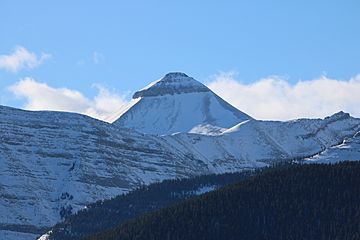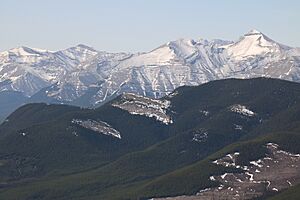Banded Peak (Alberta) facts for kids
Quick facts for kids Banded Peak |
|
|---|---|

Banded Peak
|
|
| Highest point | |
| Elevation | 2,934 m (9,626 ft) |
| Prominence | 282 m (925 ft) |
| Parent peak | Outlaw Peak (2957 m) |
| Geography | |
| Location | Alberta, Canada |
| Parent range | Kananaskis Range Canadian Rockies |
| Topo map | NTS 82J/10 |
| Geology | |
| Age of rock | Cambrian |
| Type of rock | limestone, shale |
| Climbing | |
| Easiest route | Scrambling |
Banded Peak is a tall mountain in the Canadian Rockies, located in Alberta, Canada. It stands about 2,934-metre (9,626-foot) high. This mountain is part of the Kananaskis Country area, found in the Elbow River valley.
The mountain gets its name from a special feature: a clear band of limestone rock that wraps around it. People have used the name "Banded Peak" since around 1896. In 1951, the Geographical Names Board of Canada officially recognized its name. If the weather is good, you can see Banded Peak from Highway 66.
How Banded Peak Was Formed
Banded Peak is made of sedimentary rock. This type of rock forms from layers of sand, mud, and tiny bits of sea creatures that settle over millions of years. The rocks in Banded Peak were laid down during ancient times, from the Precambrian to the Jurassic periods.
Long ago, these rocks were at the bottom of shallow seas. Later, a huge event called the Laramide orogeny happened. This was a time when powerful forces pushed the Earth's crust. These forces lifted and folded the sedimentary rock layers, creating the mountains we see today, including Banded Peak.
Weather and Climate Around Banded Peak
The area around Banded Peak has a subarctic climate. This means it has very cold winters with lots of snow. Summers are usually mild, not too hot.
Winter temperatures can drop below −20 degrees Celsius (or −4 degrees Fahrenheit). With the wind, it can feel even colder, sometimes below −30 degrees Celsius (or −22 degrees Fahrenheit).
All the rain and melting snow from the mountain flows into the Elbow River. The Elbow River then joins the Bow River, which is a larger river in Alberta.




